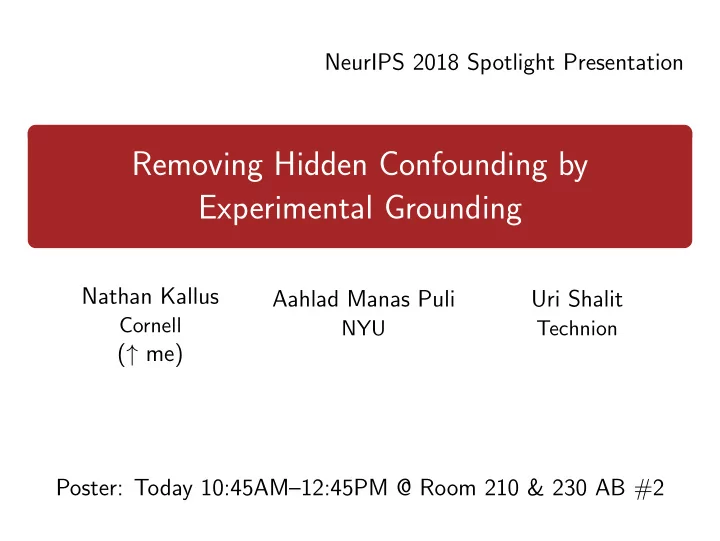

NeurIPS 2018 Spotlight Presentation Removing Hidden Confounding by Experimental Grounding Nathan Kallus Aahlad Manas Puli Uri Shalit Cornell NYU Technion ( ↑ me) Poster: Today 10:45AM–12:45PM @ Room 210 & 230 AB #2
Individual-level causal effects ◮ Patient Anna is diagnosed with type-II diabetes ◮ Blood sugar: 8.7% A1C ◮ Age: 51 ◮ Weight: 102kg Baseline covariates X ◮ BMI: 35.3 ◮ ... ◮ Q : What first-line glucose control treatment to give? Insulin ( t = 1 ) or Metformin ( t = 0 )? ◮ Want to know the individual-level causal effect of treatment, i.e. , the conditional average treatment effect (CATE) τ ( X ) = E [ Y (1) − Y (0) | X ] ◮ Y ( t ) = Anna’s potential outcome under treatment t ◮ Same Q in targeted advertising, public policy, ...
Large-scale observational data can help Age Weight BMI A1C LDL T Y 49 106 31 Insulin 9 54 89 26 Metformin 7 43 130 38 Metformin 10 . . . . . . . . . . . . . . . . . . . . .
Large-scale observational data can help Age Weight BMI A1C LDL T Y 49 106 31 Insulin 9 54 89 26 Metformin 7 43 130 38 Metformin 10 . . . . . . . . . . . . . . . . . . . . . Fit ω ( X ) = E [ Y | X, T = 1] − E [ Y | X, T = 0] to the data Outcome under metformin E.g. : Outcome under insulin Wager & Athey ’17 (CF), Shalit et al. ’17 (TARNet), ... usually assume ω = τ (no hidden confounding)
The problem with hidden confounding ◮ Hidden confounding = hidden correlations between treatments and outcome idiosyncrasies ◮ E.g. : healthier patients tend to get metformin ◮ Confounding = ⇒ ω � = τ � ◮ To some extent always unavoidable in observational data
The problem with hidden confounding ◮ Hidden confounding = hidden correlations between treatments and outcome idiosyncrasies ◮ E.g. : healthier patients tend to get metformin ◮ Confounding = ⇒ ω � = τ � ◮ To some extent always unavoidable in observational data Experimental data Observational data Unconfounded by design � Confounded by default � Limited generalizability � Covers population of interest � Small samples � Large samples �
Experimental grounding ◮ Our Q : How to use a small & limited experimental dataset to remove confounding errors in individual-level treatment effect estimates from a large observational dataset?
Experimental grounding ◮ Our Q : How to use a small & limited experimental dataset to remove confounding errors in individual-level treatment effect estimates from a large observational dataset? ◮ Outline of our method: ◮ Fit ˆ ω ( X ) using blackbox on observational data ( e.g. , causal forest, TARNet, ...) ◮ A new way to fit η ( X ) = ω ( X ) − τ ( X ) across the observational and experimental datasets ◮ Return the grounded estimate ˆ τ ( X ) = ˆ ω ( X ) − ˆ η ( X )
Experimental grounding ◮ Our Q : How to use a small & limited experimental dataset to remove confounding errors in individual-level treatment effect estimates from a large observational dataset? ◮ Outline of our method: ◮ Fit ˆ ω ( X ) using blackbox on observational data ( e.g. , causal forest, TARNet, ...) ◮ A new way to fit η ( X ) = ω ( X ) − τ ( X ) across the observational and experimental datasets ◮ Return the grounded estimate ˆ τ ( X ) = ˆ ω ( X ) − ˆ η ( X ) ◮ Our theoretical guarantee: if η is parametric and ˆ ω is τ is consistent! � consistent then ˆ ◮ Strictly weaker than assuming no confounding ( η = 0 )
Empirical results ◮ Estimate the effect of large vs small classrooms on first graders’ test scores ◮ Data from STAR experiment (Word et al. 1990) 88 85 2 step RF 2 step ridge RMSE on EVAL set ridge Y GT (UNC) 82 ridge DIFF(UNC) RF Y GT (UNC) 79 RF DIFF(UNC) ridge DIFF(CONF) RF DIFF(CONF) 76 73 0.1 0.2 0.3 0.4 0.5 size of UNCONF as fraction of rural
Thank you! Poster: Today 10:45AM–12:45PM @ Room 210 & 230 AB #2
Recommend
More recommend